Vol 3 No. 8 TROPIC LIGHTNING NEWS February 19, 1968
Index
25th's 4th Cavalry Helps Save Tan Son Nhut
By SP4 George Hairston
CU CHI - Shattering the Viet Cong attempt to overrun Tan Son Nhut
Air Base, the 25th Div's lightning-fast reaction force, the 3rd Sqdn, 4th Cav,
helped destroy the enemy force.
The Viet Cong were fighting from dug-in positions, houses and a
large factory near the airfield.
A squadron spokesman said the factory was used as a staging
ground for the attack. An extensive tunnel system was discovered beneath
the multi-story structures comprising the factory complex.
During the day-long engagement the cavalrymen captured 11
crew-served weapons, 15 AK-47s, nine RPG-2s and one CHI-COM radio.
Elements of the 2nd Bn, 27th Inf, making a house to house search
the following day found an additional 150 individual and three crew served
weapons, four radio sets and 60,000 rounds of small arms ammunition. Many
of the weapons were reported as new.
The armored assault started at 7:00 a.m. when Charlie Trp reacted,
storming into Tan Son Nhut on Highway 1 from the northwest. Near the end
of the runway C Trp made heavy contact with the enemy entrenched in houses on
the side of the highway. Several vehicles were hit with anti-tank rockets.
Delta Trp (Air) gunships were scrambled from Cu Chi. Blasting
with rockets, M60 machine guns and miniguns, the flying "Centaurs" silenced
several of the enemy positions.
Shortly after C Trp made contact, Bravo Trp raced from the Trang
Bang Bridge, 54 kms away. The enemy force was trying to outflank Charlie
Trp from the southwest.
Bravo Trp moved to C Trp's position and crashed through the Viet
Cong positions, taking a heavy enemy toll.
During the heaviest contact, B Trp commander, CPT Malcolm D. Otis
of Vicksburg, Mich., left the relative safety of his personnel carrier and led
the dismounted charge against the Viet Cong positions.
"He was armed only with a .45 cal. pistol," said 1LT Robert
Adamski, the 2nd Platoon leader from Buffalo, N.Y.
Squadron officials estimated the enemy's strength as battalion
sized. Elements of the enemy force were from a battalion of the North
Vietnamese Army's 5th Division. The battalion reportedly arrived in the
south a month ago.
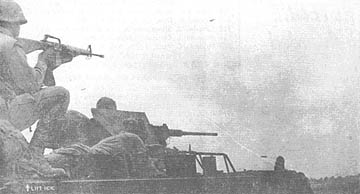 |
Cavalrymen pour automatic weapons fire into dug-in VC elements during fight for possession of southwestern end of Tan Son Nhut Air Base. (Photo by SP4 George Hairston) |
Hounds Aid Cav
HoBo Fight Kills 68
CU CHI - A relief column of U.S. infantrymen battled an estimated
Viet Cong battalion recently to aid a stricken reconnaissance patrol, 55 kms
north-northwest of Saigon.
Elements of the 2nd Bn, 27th Inf "Wolfhounds," smashed through
250 meters of enemy bunkers, machine gun nests and trenches to save a 3rd Sqdn,
4th Cav platoon that had been pinned down by heavy enemy fire.
Sixty-eight Viet Cong were killed during the bitter fighting.
Eight Americans died and 15 were wounded in the eight-hour battle.
The dug-in enemy gunners opened fire on the cavalry patrol shortly
after helicopters dropped them into a landing zone in the northern sector of the
HoBo Woods, late in the afternoon.
An hour later, the three-company relief force landed just south of
the Viet Cong's position. Describing the action, CPT Michael Wikan,
Charlie Co commander, stated that his unit came under heavy RPG, automatic
weapons and grenade fire minutes after landing. The Wolfhounds returned
fire and pushed their way to the edge of the tree line.
SSG James McCosh described the action as a pointman's fight.
"The VC would wait until you were looking down their gun barrels before
they'd shoot." It was McCosh's platoon that was the first to break
through to the cavalrymen.
LTC Walter E. Adams, Wolfhound battalion commander, said his men
did a magnificent job. "We landed just before nightfall, fought an enemy that
was armed to the teeth in there, and fought all the way through the woods to
that platoon," he said.
Adams explained that the gunships killed 25 of the 40 enemy
reinforcements who were moving up during the critical stage - moments before his
troops could link up with the reconnaissance platoon.
Many of the enemy were armed with brand new automatic weapons,
rocket launchers and equipment, and seemed to have a limitless supply of
ammunition, according to intelligence officers.
Captured in the encounter were eight AK-47 assault rifles, an SKS
assault- rifle, a badly damaged RPG-2 rocket launcher, an 82mm mortar, one U.S.
radio and hundreds of pieces of web gear, ammunition, and documents.
Trooper Storms Bunker
3RD BDE - "I've been looking for Charlie since he got a couple
of my buddies the other night." The soldier paused. "Now we're
even." So spoke SP4 William R. Richardson, Alpha Co, 2nd Bn (Mech), 22nd
Inf, of Okmulgee, Okla., describing how he stormed a bunker, killing two Viet
Cong and detaining a third.
"As we were sweeping through the jungle we ran onto an enemy base
camp. We pulled back for an airstrike, then moved on line with the tracks
leading and attacked the base camp. The lieutenant held up the tracks when
they ran onto the bunkers and sent the infantry on ahead to clear them.
"I held my squad up when we got real close to the bunkers and
went on ahead to check them out. When I went around behind one bunker I
suddenly noticed a Charlie inside it pointing an RPG at one of our tracks.
I immediately let him have it with a burst from my M-16. I then noticed a
second man in the bunker, and shot him. I shot at a third man, but missed.
He ran back into a part of the bunker where I couldn't reach him and shouted
that he surrendered. I told him to come out. When he didn't, I
jumped in and threw him out. I started to bring him back to the track when
he tried to run off into the jungle. I stopped him and with a more
watchful eye brought him back to the track. That was all there was to
it."
Two days after the incident, MG F. K. Mearns, commanding general of
the 25th Inf Div, flew out to the field and personally pinned the Silver Star on
the young warrior, and promoted him to sergeant at the same time.
Catches Bullet In His Mouth
1ST BDE - An impromptu ambush in War Zone C recently netted a U.S.
infantryman a Viet Cong body count of five and a mouthful of lead.
SP4 Michael Walker from Antioch, Calif., was the first man of the
25th Div's 4th Bn, 9th Inf, ambush patrol to open fire on six approaching Viet
Cong.
Five of the enemy were killed by Walker's M79 round, however, the
sixth VC fired a shot at Walker before fleeing.
"I guess it was my day," says Walker, "because the bullet hit
a tree and split in half. One-half nicked my lip and landed in my mouth.
The medics didn't have to evacuate me . . . I just spit it out."
This "Fish" Got Away, But He Sure Had Help
1ST BDE - It seems that fishermen are always talking about "the
one that got away." Several members of B Trp, 3rd Sqdn, 17th Air Cav,
have been expounding on the same subject lately, but the circumstances are
entirely different than any story told by a would-be fisherman.
Gunships of the troop were engaged in a fire mission on an enemy
base camp some 7 kms southeast of the 25th Inf Div's base camp at Cu Chi.
Action had been heavy and the gunships had inflicted heavy damage to the camp
and the Viet Cong.
Circling the area after the battle, an enemy soldier was spotted in
a nearby canal. Realizing a chance to detain a VC, the ships swooped down
for a landing, at which time the man ran into a thicket of high grass.
"When he went into the grass we lost track of him," said one of
the pilots, CPT Donald E. Jones of Vine Grove, Ky. "But we hovered over
the thicket and flattened the grass with our prop blast, exposing him."
As the ships landed near the VC, 1LT Robert S. Reed of Tulsa,
Okla., an artillery observer working with the squadron from the 2nd Bn, 32nd
Arty, jumped from his aircraft and grappled with the enemy soldier. As he
was dragging the detainee toward the awaiting aircraft, the air suddenly became
alive with enemy automatic weapons fire. Releasing the man Reed ran for
cover.
With the first burst of fire, the awaiting aircraft quickly lifted
out of the area leaving Reed behind. Armed with an M-79 grenade launcher
the embattled lieutenant fired in the direction of the attackers. By that
time the gunships had also engaged the enemy.
"I made two quick passes around the area and dropped in low over
Reed's position," related Jones. "As I came in, he grabbed one of
the landing skids and I lifted out of the area. The ship's crew members
pulled him into the ship and out of danger."
Enemy Sign No Good, Stops GIs Short Of Trap
2ND BDE - Two Americans and a South Vietnamese interpreter stopped
recently to look at a road sign left by the Viet Cong . . . just out of range of
an enemy claymore mine.
The sign, ironically enough, meant "Death to the G.I."
Tran Van Sinh, an interpreter with C Co, 2nd Bn, 27th Inf
"Wolfhound's," called for PFC Daniel B. Gonzales of La Puente, Calif., and
another man to look at a sign he had found.
While the trio inspected the poster, which depicted an American
with a death sign on his helmet, Viet Cong opened fire with a claymore and
automatic weapons on the front of the column.
Two enemy died in the ensuing fight.
"If Sinh hadn't stopped us to look at the poster, we would have
walked right into the claymore," Gonzales said.
Page 2 TROPIC LIGHTNING NEWS February 19, 1968
Decorated
| DISTINGUISHED FLYING CROSS | |
|
1LT Gerald J. Smith, 116th Aslt Hel Co, 269th Avn Bn 1LT Harold D. Dye, Co A, 25th Avn Bn 1LT Charles J. Slimowicz Jr., Co B, 25th Avn Bn 2LT Michael L. Cheney, 116th Aslt Hel Co, 269th Avn Bn |
2LT Thomas C. Pool, 116th Aslt Hel Co, 269th Avn Bn CW2 Neil A. Townsley, 116th Aslt Hel Co, 269th Avn Bn WO1 Paul R. Jenkins, 116th Aslt Hel Co, 269th Avn Bn |
|
ARMY COMMENDATION MEDAL (HEROISM) |
|
|
CPT Samuel R. Noto, HHC, 2nd Bn, 22nd Inf WO1 James A. Watts, 116th Aslt Hel Co SP4 John W. Brakefield, 116th Aslt Hel Co, 269th Avn Bn SP4 Robert W. Vrandenburgh, 116th Aslt Hel Co, 269th Avn Bn SP4 John R. Young, 116th Aslt Hel Co, 269th Avn Bn SP4 Danny Utinske, 116th Aslt Hel Co, 269th Avn Bn SP4 Willie L. Hamell, Co B, 2nd Bn, 12th Inf SP4 Kenneth M. Miller, Co D, 2nd Bn, 12th Inf SP4 Jack L. Knittle, 116th Aslt Hel Co, 269th Avn Bn SP4 Fred D. Dague, 116th Aslt Hel Co, 269th Avn Bn SP4 David L. Allen, 16th Aslt Hel Co, 269th Avn Bn SP4 Laurie L. Linder Jr., 116th Aslt Hel Co, 269th Avn Bn SP4 Jerral L. Piatt, 116th Aslt Hel Co, 269th Avn Bn SP4 Daniel M. Shultz, 116th Aslt Hel Co, 269th Avn Bn SP4 Cleman A. Durst, 116th Aslt Hel Co, 269th Avn Bn SP4 Jerome P. Klein, 116th Aslt Hel Co, 269th Avn Bn SP4 Paul W. Geving, 116th Aslt Hel Co, 269th Avn Bn SP4 David K. Pond, 116th Aslt Hel Co, 269th Avn Bn SP4 Thomas L. Major, 116th Aslt Hel Co, 269th Avn Bn SP4 Richard W. Moreland, 116th Aslt Hel Co, 269th Avn Bn SP4 Michael T. Kobert, 116th Aslt Hel Co, 269th Avn Bn SP4 Alex H. Morris, 116th Aslt Hel Co, 269th Avn Bn SP4 Gregory C. Anderson, 116th Aslt Hel Co, 269th Avn Bn SP4 James E. Johnson, 116th Aslt Hel Co, 269th Avn Bn SP4 Raymond E. Wunderle, 116th Aslt Hel Co, 269th Avn Bn SP4 John M. Sloke, 116th Aslt Hel Co, 269th Avn Bn SP4 Daniel L. Johnson, 116th Aslt Hel Co, 269th Avn En SP4 Charles R. Edwards, 116th Aslt Hel Co, 269th Avn Bn SP4 Joseph J. Gormley, 116th Aslt Hel Co, 269th Avn Bn SP4 Richard A. Griffis, 116th Aslt Hel Co, 269th Avn Bn SP4 Ronald W. Patterson, 116th Aslt Hel Co, 269th Avn Bn |
PFC William E. Geer, 116th Aslt Hel Co, 269th Avn Bn PFC Billy J. Chandler, Co B, 2nd Bn, 12th Inf PFC Andrew Boiling, Co B, 2nd En, 12th Inf PFC John C. Henry , Co B, 2nd Bn, 12th Inf PFC John Caria, 116th Aslt Hel Co, 269th Avn Bn PFC Gary J. Wisbar, 116th Aslt Hel Co, 269th Avn Bn PFC Patrick R. Cook, Co D, 2nd Bn, 12th Inf PFC Ronald Flynn, Co D, 2nd Bn, 12th Inf PFC Warren R. Burton, Co D, 2nd Bn, 12th Inf PFC Terry L. Kelly, Co D, 2nd Bn, 12th Inf PFC Chester Bullard Co D, 2nd Bn, 12th Inf PFC Clyde R. Gunn, Co D, 2nd Bn, 12th Inf PFC Ramond Isias, Co D, 2nd Bn, 12th Inf PFC Gene R. Wortman, Co B, 2nd Bn, 12th Inf PFC Kary L. Munsey, Co B, 2nd Bn, 12th Inf PFC Billy R. Howard, Co B, 2nd Bn, 12th Inf PFC Charles L. Hoard, Co B, 2nd Bn, 12th Inf PVT Terry L. Mohme, Co B, 2nd Bn, 12th Inf PVT Oliver L. Fenceroy, Co B, 2nd Bn, 12th Inf PFC Alan F. Horton, 116th Aslt Hel Co, 269th Avn Bn PFC Robert Dixon, 116th Aslt Hel Co, 269th Avn Bn PFC Jerome P. Klein, 116th Aslt Hel Co, 269th Avn Bn PFC James H. Givens, Co A, 2nd Bn, 12th Inf PFC Lloyd Grazier, Co D, 2nd Bn, 12th Inf PFC Joe A. Webb, Co B, 2nd Bn, 12th Inf PFC Richard Walton, Co B, 2nd Bn, 12th Inf PFC Acie H. Gray, Co B, 2nd Bn, 12th Inf PFC Shed B. Waddy III, Co B, 2nd Bn, 12th Inf PFC Joy L. Hodges, Co B, 2nd Bn, 12th Inf PFC John W. Nix, Co D, 2nd Bn, 12th Inf |
|
ARMY COMMENDATION MEDAL (MERIT) |
|
|
SP5 Daniel Farren, Co B, 25th Avn Bn SGT Robert E. Masterson, Co A, 25th Avn Bn SP4 Jerry E. Demlinger, 116th Aslt Hel Co, 269th Avn Bn SP4 Todd J. Frye, Co B, 25th Avn Bn SP4 Johnny E. Kilgore, 116th Aslt Hel Co, 269th Avn Bn SP4 Michael T. Kobert, 116th Aslt Hel Co, 269th Avn Bn SP4 Donald J. Kish, 116th Ash Hel Co, 269th Avn Bn SP4 James B. Montana, Co B, 25th Avn Bn |
SP4 Guy D. Miller, Co A, 25th Avn Bn SP4 Larry J. Kerr, Co A, 25th Avn Bn SP4 Jimmy L. Weber, Co A, 25th Avn Bn SP4 John A. Carpentieri, Co A, 25th Avn Bn SP4 Robert L. Williams, Co A, 25th Avn Bn PFC Conroe F. Somerville, Co A, 25th Avn Bn PFC Albert L. Lewis, Co B, 25th Avn Bn PFC Duane L. Mecham, 116th Aslt Hel Co, 269th Avn Bn |
Contract For CHEYENNE Is Awarded
WASHINGTON (ANF) - The U.S. Army has awarded the
Lockheed-California Co., of Van Nuys, Calif., a $21,400,000 contract to begin
production of AH-56A CHEYENNE helicopters.
The heavily armed CHEYENNE is highly maneuverable and is the first
rotor craft ever designed from its inception as an integrated weapons system.
With a top speed of more than 250 miles per hour, the helicopter
will provide direct fire support in combat landing zones and escort troop
carrying helicopters.
The two-man CHEYENNE is approximately 55 feet long, has a
tail-mounted propeller in addition to rotor blades, and is equipped with
retractable landing gear. The rotor blades are fixed rigidly to the mast.
Lockheed has already built 10 AH-56A prototypes under the Army
contract, and will build 375 CHEYENNEs under the production option of the
current contract.
No 'Freeze' On Any Discharges
DOD Says After Reserve Call-Up
"There is no 'freeze' on discharges and retirements in any of
the services," the Department of Defense said the last week in January,
replying to rumors following the call-up of certain reservists. At
present, there is no authority to extend enlistment contracts for enlisted men.
Referring to the status of regular officers, DOD said all services
use a selective involuntary retention program.
There is an individual determination as to whether a regular
officer's request for voluntary retirement or resignation will be accepted or
deferred because his services are needed. The same applies for voluntary
retirement for Reserve officers.
Reserve officers' requests for release from active duty are being
approved unless the officer has not completed a term of active duty to which he
is obligated or for which he consented.
The call-up of certain Ready Reserve units of the Air Force and
Navy and the Air National Guard was taken as "a precautionary measure to
strengthen our forces" following the capture of the USS Pueblo by North
Koreans on Jan. 23.
Although there was no call-up of Army and Marine Corps Reserve
units, procedures on exemptions were spelled out should the situation change:
• If Army Reserve and/or National Guard units are called to
active duty, exemption policies are covered in AR 601-25.
• If any Marine Corps units are called, the Marine Corps will
decide at that time who, if anyone, will be exempt. At this time, no one
would be exempt.
For the services - Navy and Air Force - involved in the recent
call-up, "all high school students are exempt."
In addition, the Air Force is looking into all other possible
exemption areas.
In the Navy, high school graduates or drop-outs are scheduled for
call-up. College students can be deferred until the end of their current
quarter, semester or tri-semester. College seniors can request an
additional quarter, semester or tri-semester if this would permit them to
graduate.
The TROPIC LIGHTNING NEWS is an authorized publication of the 25th
Infantry Division. It is published weekly for all division units in the Republic of
Vietnam by the Information Office, 25th Infantry Division, APO San Francisco
96225. Army News Features, Army Photo Features, Armed Forces Press Service and Armed
Forces News Bureau material are used. Views and opinions expressed are not necessarily
those of the Department of the Army. Printed in Tokyo, Japan, by Pacific Stars and
Stripes.
MG F. K. Mearns . . . . . . . . . Commanding General
MAJ Bernard S. Rhees . . . . Information Officer
SSG Dave Wilkinson . . . . . Editor
SP5 Dave Cushman . . . . . . . Editorial Assistant
Page 3 TROPIC LIGHTNING NEWS February 19, 1968
|
|
(This article on Vietnam - the people and
culture - is reprinted in the TROPIC LIGHTNING NEWS courtesy of SEVENTH AIR
FORCE NEWS. We hope to be able to bring you more articles of this nature
in future issues. THE EDITOR)
The Republic of Vietnam extends in crescent shape along the
southeastern face of the Indochinese peninsula. The country is less than
half the size of California and long and narrow like that state.
From its 45-mile-long border with North Vietnam at the 17th
parallel southward to the tip of the Mekong Delta, Vietnam has 1,500 miles of
coastline on the South China Sea and the Gulf of Siam.
Its western borders with Cambodia and Laos trace some 900 miles
through delta, jungle, plains and mountains.
The northern two-thirds of Vietnam is dominated by the rugged
mountains of the Annamite chain. Peaks lie generally between 2,000 and
7,000 feet above the sea, but some peaks rise to over 10,000 feet and are
comparable to parts of the Alps or the Rockies.
The Annamite chain extends from the border with North Vietnam
southward to within 60 miles northeast of Saigon. In places mountain spurs
jut out into the sea dividing the coastal plain into sections. Between
these spurs, deltas have formed around the short rivers which run from the
mountains down to the sea.
Southwest of the mountain plateau, the land descends through flat
plains covered with jungle and savannah grass to the Mekong Delta.
The Delta extends generally southwest from Saigon. It is a
vast alluvial plain fed by the many mouths of the Mekong River, and crisscrossed
by a dense canal work.
The Mekong Delta is capable of yielding five million tons of rice
yearly. It is the major rice-producing area of Southeast Asia and the home
of six million people.
In the highlands of Vietnam, however, the nights are cool
regardless of the season. Along the central coast the rainy season begins
in October and lasts until March. July and August are the hottest and most
humid months here.
In the southern delta region the rains usually begin in late May
and continue through September.
This is an agricultural country with a soil and climate combination
ideal for growing rice, and the bulk of its 15.5 million inhabitants exist by
cultivating rice.
Since two-thirds of the country is mountainous, the overwhelming
majority of the population lives in the open lowland plains of the rice-rich
deltas.
These include the Mekong Delta and a whole series of smaller deltas
along the coast.
The vast uplands are largely left to the ethnically separate and
primitive mountain tribes.
An estimated 15 per cent of Vietnam's population lives in cities.
Saigon is the largest with about two million people. Da Nang runs a
distant second with a population of about 110 thousand.
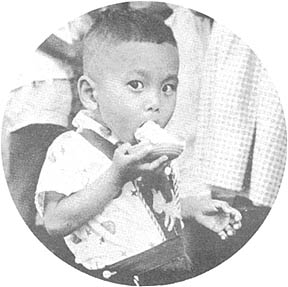 |
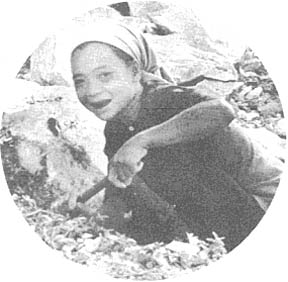 |
| Treat Time for A Vietnamese Child | Woman Pauses From Clearing Rocks |
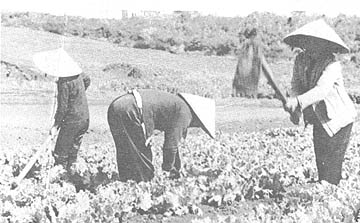 |
|
Women Till the Vegetable Gardens at Da Lat |
Page 4-5 TROPIC LIGHTNING NEWS February 19, 1968
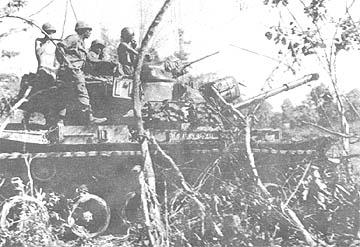 |
An M-48 tank from the 2nd Bn, 34th Armor, moves through dense jungle during Operation Yellowstone in War Zone C. (Photo by SP4 John Seymour)
|
|
The going is rough for men of the 2nd Bn, 12th Inf, near the Cambodian border. (Photo by SP4 Joseph Hettermann)
|
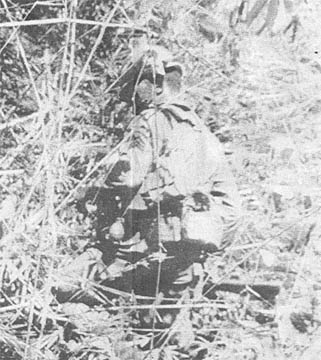 |
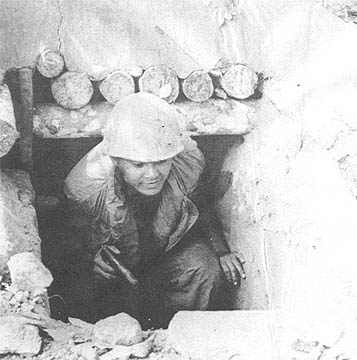 |
A tunnel rat of the 4th Bn, 23rd Inf, emerges from a VC bunker found in the Filhol Plantation recently. (Photo by PFC William Strout)
|
| Armored vehicles of the 3rd Sqdn, 4th Cav, move through heavy undergrowth on a search and destroy mission near Cu Chi. (Photo by SP4 George Hairston) | 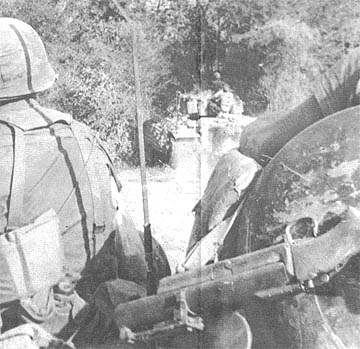 |
Page 6 TROPIC LIGHTNING NEWS February 19, 1968
12th Evac Nurse Plans VN Return
CU CHI, (USARV-IO) - When 1LT Phyllis Seaton completes her tour of
duty in Vietnam as an Army nurse, she will return to Vietnam to begin a hospital
and school in the village of Phu Cap, in an area infested by the Viet Cong.
It doesn't faze the young nurse, though. She is already
running an extensive MEDCAP from her post at the 12th Evac Hosp at the 25th Inf
Div's base camp here.
She will also enlist four young Vietnamese to help her with the
project, which will consist of a small school, a ten-bed hospital and a rural
maternity center.
"This is no charity operation," said Seaton. "I'll tell the
farmers that I will take care of their medical needs if they will plow my rice
field or trade me some vegetables or do some work around the center."
The lieutenant will have company in her venture. She has
adopted a two-year-old Vietnamese girl, who will live with her at the hospital.
In addition, the lieutenant speaks fluent Vietnamese. She
already has put it to use in the 12th Evac's Vietnamese ward where she is a
night nurse.
For her work at the hospital and on MEDCAPS, she has been honored
with several decorations from the Government of Vietnam.
6 VC Die As Manchus Storm Trench
1ST BDE - Manchu cussedness and cunning recently accounted for six
Viet Cong killed and six Bronze Stars.
Elements of Co A, 4th Bn, 9th Inf Manchus, encountered the enemy in
a W-shaped trenchline of five reinforced bunkers. For about 20 minutes the
Manchus were pinned down by intense AK-47 fire.
SSG Roman Jones of Columbus, Ga., his AR-15 shot out of his hands,
ordered his men to shift back and to the left. The VC, thinking the
Americans were beaten, crawled out after them.
Meanwhile, Alpha Co CO, CPT Albert Killgrove of Portland, Ore, had
encircled the unsuspecting enemy with other troops under his command.
"We hit Charlie with everything at once," said SSG Louie
Williford of Thompson, Ga., "grenades, automatic weapons - the works."
The guerrillas, now totally disorganized, ran for the trenchline.
Several escaped down a tunnel, leaving six of their comrades behind.
For their actions during the hour-long battle, Jones and five of
his men received the Bronze Star with V-device.
22nd Inf Smashes VC Camp
3RD BDE - Several outstanding examples of personal bravery were
manifested several days ago when Alpha Co, 2nd Bn (Mech), 22nd Inf, led by CPT
Alan R. Wetzel of Lake Worth, Fla., assaulted an enemy base camp, netting six
Viet Cong and a detainee. There were no friendly casualties.
About 11:30 a.m., the "Triple Deuces'" Alpha Co ran into an
enemy base camp. After pulling back to allow for an air strike and
artillery prep, they moved back on line and swept toward the enemy positions
with armored personnel carriers, reconning with .50 cal. machine guns leading
the dismounted infantry.
When one track ran over a bunker, and 10 to 15 more were spotted,
the 1st Platoon Leader, 2LT Robert S. Hutchinson of Hacienda Heights, Calif.,
halted his vehicles and sent the dismounted infantry ahead to check and clear
the bunkers.
SP4 William R. Richardson of Okmulgee, Okla., led his squad forward
toward the bunkers when all at once he noticed a Viet Cong standing up pointing
an RPG-2 launcher at the lead track. Without hesitating, Richardson
stormed the bunker, killing the enemy with a burst from his M-16. He then
whirled on a second Viet Cong who was attempting to bring his AK-47 to bear on
Richardson and shot him. He then attacked and detained a third Viet Cong.
On the 3rd Platoon portion of the line, PFC Robert A. Langford of
Silver Hill, Ala., drew AK-47 fire from a bunker. Immediately returning fire,
Langford assaulted the bunker into which he emptied four M-16 magazines.
He then ran back to his APC, procured a hand grenade, returned to the bunker,
and tossed it in. After the blast, a check of the bunker produced the
bodies of four Viet Cong.
This Smoke Popped Strictly By Accident
1ST BDE - PFC Clarence Reed, of Batesburg, S.C., became the center
of attention while on a recent search and destroy operation near the Cambodian
border, as an enemy sniper shot a hole in his smoke grenade which was attached
to his web belt.
Bravo Co of the 2nd Bn, 14th Inf, was in heavy contact with a large
size company of mixed Viet Cong and North Vietnamese regulars. In the
words of platoon leader, 1LT Ralph Timperi of Dedham, Mass., "The enemy was
firing at us from the front and both flanks and needless to say, the men were
very occupied."
Reed was also very occupied and when he felt something shake his
web belt, he paid little attention to it until he noticed his clothes turning
purple. Reed unharnessed his web gear and dropped it to the ground.
"Some of the guys yelled at me and asked why I popped a smoke
grenade and I told them I didn't! " Reed replied.
It wasn't until after the firing came to a halt, that the men
found out the truth about "who popped the smoke." Inspecting the used
grenade, proved that Charlie had shot a hole in one side of the grenade and
caused it to ignite.
Reed concluded, "It's nice to wear different colors of clothing
once in awhile, but I'll stick to OD any day, rather than have Charlie change
my colors by 'popping my smoke.'"
Inf Destroys "VCU" Campus
2ND BDE - Discovering enemy base camps, rice caches and weapons is
pretty routine stuff for 25th Inf Div soldiers, but a Viet Cong boarding school
is a different matter.
Men of the 2nd Bn, 27th Inf "`Wolfhounds," were searching a
wooded area 45 kms northwest of Saigon when they came upon an underground bunker
containing 16 cots.
Located near the U-shaped bunker were a series of U-shaped
bleachers. There were no fighting positions nearby.
"Maybe they call it 'VCU'," punned one amused soldier as he
looked over the "campus."
The Wolfhounds later destroyed the structures.
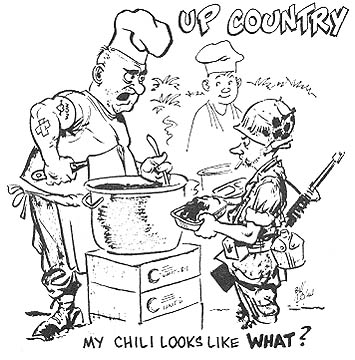 |
Page 7 TROPIC LIGHTNING NEWS February 19, 1968
Engrs & Avn Set Stage For Extraction
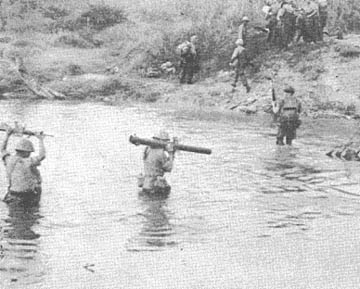 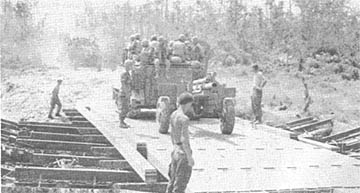 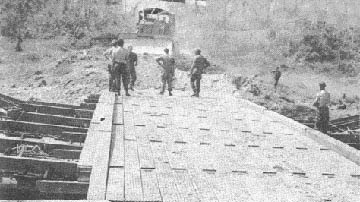 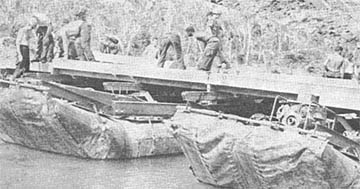 |
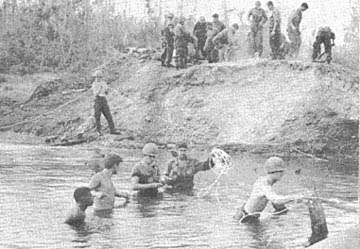 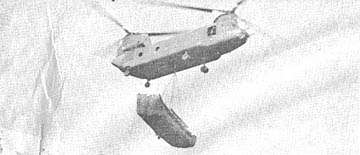 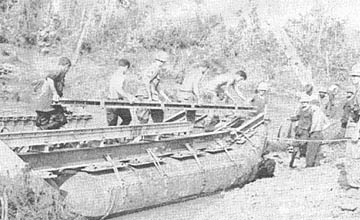 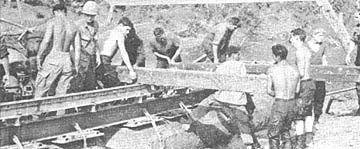 |
Army Engineer and Aviation units teamed up during Operation Yellowstone to make an extraction route possible for 3rd Bde infantrymen. Delta and Echo companies of the 65th Engr Bn, together with Chinook helicopters of the 242nd Avn Co, made possible a river crossing on Route 244, 48 kms north-northeast of Cu Chi. The route was used to extract Co C, 2nd Bn, 22nd Inf, from fire support base Burt.
Page 8 TROPIC LIGHTNING NEWS February 19, 1968
Friendship Gained Thru MEDCAPs
3RD BDE - "At first the villagers weren't too receptive to
our treatment but after returning every Wednesday and Sunday, they knew our
MEDCAP Team had come to help them." So describes a small portion of the
civil action of the 2nd Bn, 12th Inf.
The MEDCAPs are one of the projects of the Battalion S-5 in
cooperation with the Battalion Aid Station, which are gaining the friendship of
the villagers of AP-5, a small hamlet just cast of the 3rd Bde base camp at Dau
Tieng.
When the first MEDCAP was held over two months ago it consisted of
mostly young children who would come to get the candy the "Bac Si" would
give them after being treated. But now both young and old alike are
standing in line to receive medication. On an average Sunday, when most of
the villagers are not working the nearby Michelin Rubber Plantation, as many as
90 Vietnamese have been treated.
One of the first patients treated by the MEDCAP was a 10-year-old
girl who had sores over most of her body, causing the child great pain.
After being treated twice weekly for about a month the child's infections had
healed almost completely and she had been relieved of the unnecessary pain.
"These continued treatments were not available prior to
conducting bi-weekly MEDCAPs at AP-5," said CPT Paul Rhodes, the battalion
surgeon from Winchester, Va. "Most of the MEDCAPs were held in
conjunction with tactical operations and very seldom were we able to follow up
the patients we treated. Now with continued treatment, we can provide
better medical care for the villagers and it is much more rewarding for us to
see our patients improving as we return each week."
| PEEK-A-BOO - Just be still for a moment and it will be all over, says CPT Paul Rhodes, the battalion surgeon, during a MEDCAP near Dau Tieng held by the 2nd Bn, 12th Inf medical team. (Photo by SP4 Joseph Hettermann) | 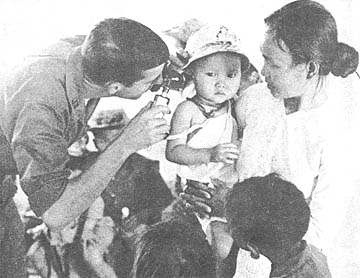 |
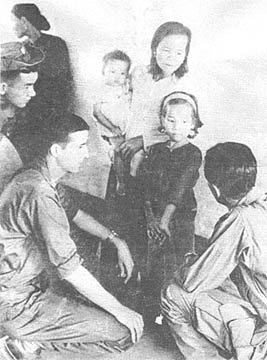 |
WHAT SEEMS TO BE THE TROUBLE - Through use of an interpreter, the battalion surgeon of the 2nd Bn, 12th Inf, explains to a patient from the hamlet of AP-5 that he is there to help her feel better. (Photo by SP4 Joseph Hettermann) |
Dropped Weapon Is Useful
3RD BDE - Dropping an AK-47 proved fatal to several Viet Cong
recently during Operation Yellowstone.
When informed by aerial observers that three Viet Cong had been
spotted in an old base camp, Co A, 2nd Bn (Mech), 22nd Inf, led by CPT Alan R.
Wetzel, went to the site to investigate.
They moved in with infantry dismounted and .50s blazing and had run
over several spiderholes when suddenly a Viet Cong, holding a hand grenade in
each hand, stood up directly in front of the point platoon. Fire was
quickly directed at the man who ducked down into his bunker.
LT William Ruha, Alpha's forward observer, grabbed an AK-47,
assaulted the bunker emptying the weapon into it and following the bullets with
a grenade. A check of the bunker produced two enemy bodies. On the
other side of the line, SP4 Jerome Kelly shot another Viet Cong in a bunker.
After the assault several documents and 20 brand new knapsacks,
along with 20 miles of commo wire and 20 potato-masher grenades were found in
the base camp.
Cluck, Said The Chicken
Yum, Said The Soldiers
1ST BDE - During, a recent search and destroy mission in War Zone
C, troopers from the 4th Bn, 9th Inf "Manchus," discovered an unusual Viet
Cong cache.
They were moving slowly through dense jungle when they heard
strange noises on their left flank. Two men moved out cautiously to check.
"It sorta sounded like chickens," said SP4 Thomas McDermott of
Columbus, Ohio, "but I couldn't believe that's really what it was until I
saw it."
The 25th Div infantrymen found that the noises were coming from an
old ox cart which had been converted into a crude chicken coop for a dozen
clucking hens.
SP4 James Kyzour of Cleveland, Ohio, moved forward and discovered
that the door on the coop was boobytrapped with a hand grenade. Kyzour
dismantled the boobytrap, and the chickens were quickly passed out to the other
Manchus.
A little while later the battalion set up their perimeter for the
night and the riflemen roasted the chickens for supper.
"It was pretty good," recalled Kyzour, "sure wish I'd taken
along some barbecue sauce tough."
Cav Unit Lauded
1ST BDE-The 3rd Sqdn, 17th Air Cav, was recently lauded for their
performance in support of the 25th Inf Div during "Operation Yellowstone."
COL Donald D. Dunlop, assistant division commander, made the
remarks in behalf of the division commander, MG F. K. Mearns, during a squadron
dine-in at the Philippine Officers Mess at Tay Ninh.
"Everyone within the 25th Division who knows of your actions
holds nothing but the highest esteem for your unit" stated COL Dunlop.
15 Cong Find
Card Playing Proves Wasteful
CU CHI - Fifteen Viet Cong recently found that it doesn't pay to
waste time playing cards, because it netted U.S. cavalrymen a royal flush.
The Viet Cong were discovered by a two-platoon element of the 3rd
Sqdn, 4th Cav, during a sweep through an abandoned farm, 51 kms northwest of
Saigon.
Seven of the enemy were killed and the other eight detained.
According to SSG Franklin Folsom, the first contact was made when
the cavalrymen found four large spider holes hidden in a hedgerow. Three
were found to be empty, but a fourth yielded three detainees.
In the same hedgerow, the dismounted cavalrymen discovered another
spider hole containing two men. One came out fighting and became the first
KIA. The second man turned himself over to the cavalrymen. From his
clothing, equipment and size, an ARVN interpreter thought that he was not a
local, but an advisor.
"The man the interpreter thought was an advisor was fully six
feet tall," said Folsom, "He was well equipped, and not dressed like the
rest."
Two more spider holes produced five more KIAs and one detainee.
Another individual charged from the woods toward the Americans and shortly
became the seventh KIA.
"Three more men deciding not to take any chances turned
themselves over to us shortly after that," explained 1LT Donald J. Russin Jr.,
platoon leader from Cleveland, Ohio.
According to the interpreter the group was waiting to go to a
meeting. To kill time, a few members played cards while waiting in
underground bunkers.
Thanks to
James E. Johnson, 116th AHC, 269th Aviation Bn. for sharing this issue,
Ron Leonard, 25th Aviation Bn. for locating and mailing the issue,
Kirk Ramsey, 2nd Bn., 14th Inf. for creating this page.
This page last modified 8-12-2004
©2004 25th Infantry Division Association. All rights reserved.